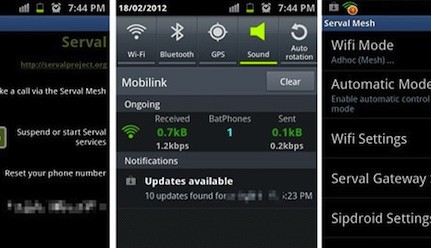Serval Mesh: Operating Mobile Phones Without a Cellular Network
July 18, 2013
on
on

The Serval Project team has developed an Android app which turns mobile phones into a mesh network running on Wi-Fi. To extend the limited range Wi-Fi offers they are now developing a hardware solution called the Serval Mesh Extender.
The open source Serval Mesh software enables mobile phones to communicate with each other independent of supporting infrastructure. Using Wi-Fi the phones form a self-configuring network to exchange files, voice and text messages.
Founder of the project Dr. Paul Gardner-Stephens a Humanitarian Telecommunications Fellow at Flinders University, Australia, developed the app with disasters zones and remote areas in mind, where the cellular network infrastructure is either destroyed or was never deployed in the first place.
But the app has its limitations. Wi-Fi has a range of about a hundred meters and ad-hoc Wi-Fi networking drains the phone’s battery. To address these issues the Serval team developed the Mesh Extender, a prototype hardware platform that extends the range of the network up to thousands of meters using additional radio technologies. It can also serve as a network access point for nearby mobile phones to help them save battery power.
The Serval team is now running an Indiegogo crowdfunding campaign aiming for $300,000 to improve and manufacture the Mesh Extender. You can also support the open source, not-for-profit project by joining the developer team.
While developing the Mesh app the team ran into another problem. Most mobile phone manufacturers do not support mesh networks as many of them distribute their devices through telecommunications companies. To get a phone to operate as a node in a mesh network, the user must first get root access to the phone to circumvent the default restrictions. But with the Mesh Extender functioning as a host, unrooted phones can join the network in client mode.
The core value driving the Serval project is that the ability to communicate is a human right. Since privacy is an essential part of being able to communicate freely, security measures such as end-to-end encryption are baked into the software.
In 2011 the Serval system was used in a pilot project [PDF] in Port Harcourt, Nigeria. There, crappy infrastructure and high cost prevent people living in shanty towns from using cellular technology effectively. When the government announced plans to demolish the slums in 2008, the inhabitants started to organize themselves in an effort to save their communities. It became clear that better communication systems were needed to exchange information between the town’s people themselves and NGOs. The Serval Mesh system (without the Mesh Extender) was deployed in November 2011. There was an noticeable increase in digital information exchange because people no longer needed to pay for a connection. However, the limited range (60 meters in an urban area) proved problematic.
Part of the funds of the crowdfunding campaign will go to getting Mesh Extenders into the hands of underserviced communities.
[Edit: July 19, 2013. Port Harcourt use case added.]
Via: Technology review
Image: Serval Mesh UI
The open source Serval Mesh software enables mobile phones to communicate with each other independent of supporting infrastructure. Using Wi-Fi the phones form a self-configuring network to exchange files, voice and text messages.
Founder of the project Dr. Paul Gardner-Stephens a Humanitarian Telecommunications Fellow at Flinders University, Australia, developed the app with disasters zones and remote areas in mind, where the cellular network infrastructure is either destroyed or was never deployed in the first place.
But the app has its limitations. Wi-Fi has a range of about a hundred meters and ad-hoc Wi-Fi networking drains the phone’s battery. To address these issues the Serval team developed the Mesh Extender, a prototype hardware platform that extends the range of the network up to thousands of meters using additional radio technologies. It can also serve as a network access point for nearby mobile phones to help them save battery power.
The Serval team is now running an Indiegogo crowdfunding campaign aiming for $300,000 to improve and manufacture the Mesh Extender. You can also support the open source, not-for-profit project by joining the developer team.
While developing the Mesh app the team ran into another problem. Most mobile phone manufacturers do not support mesh networks as many of them distribute their devices through telecommunications companies. To get a phone to operate as a node in a mesh network, the user must first get root access to the phone to circumvent the default restrictions. But with the Mesh Extender functioning as a host, unrooted phones can join the network in client mode.
The core value driving the Serval project is that the ability to communicate is a human right. Since privacy is an essential part of being able to communicate freely, security measures such as end-to-end encryption are baked into the software.
In 2011 the Serval system was used in a pilot project [PDF] in Port Harcourt, Nigeria. There, crappy infrastructure and high cost prevent people living in shanty towns from using cellular technology effectively. When the government announced plans to demolish the slums in 2008, the inhabitants started to organize themselves in an effort to save their communities. It became clear that better communication systems were needed to exchange information between the town’s people themselves and NGOs. The Serval Mesh system (without the Mesh Extender) was deployed in November 2011. There was an noticeable increase in digital information exchange because people no longer needed to pay for a connection. However, the limited range (60 meters in an urban area) proved problematic.
Part of the funds of the crowdfunding campaign will go to getting Mesh Extenders into the hands of underserviced communities.
[Edit: July 19, 2013. Port Harcourt use case added.]
Via: Technology review
Image: Serval Mesh UI
Read full article
Hide full article


Discussion (3 comments)